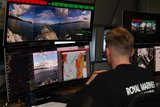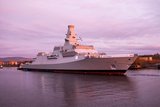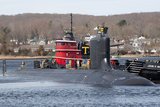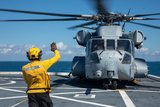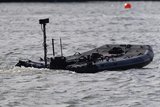Indonesia launches coast guard’s largest OPV
On 21 November the Indonesian shipbuilder PT Palindo Marine launched a 110m OPV destined for the Indonesian Maritime Security Board, which is the country’s coast guard agency.
The 2,400t ship will be the largest platform within the Badan Keamanan Laut Republik Indonesia (BAKAMLA). This coast guard force is ill equipped to monitor Indonesia’s vast archipelagic waters, currently relying on six 48m patrol boats.
RAdm Ari Soedewo, chief of the BAKAMLA, said in a statement read out at the launch ceremony in Batam that it was 'a historical event for Indonesia' and that 'never again will we be looked down upon'
Already have an account? Log in
Want to keep reading this article?
More from Naval Warfare
-
![Hanwha wins Australian government approval to increase its stake in Austal]()
Hanwha wins Australian government approval to increase its stake in Austal
The contract would mean the two shipbuilders can collaborate strategically and enhance shipbuilding capabilities in Western Australia.
-
![Royal Australian Navy sizes up modernisation plans for new and existing capabilities]()
Royal Australian Navy sizes up modernisation plans for new and existing capabilities
The Australian navy is pushing ahead with its efforts to modernise its workforce and capabilities while balancing risky submarine upgrades, ageing Collins-class boats and a shrinking minehunter fleet. Head of navy capability RAdm Stephen Hughes updated Shephard on the force’s progress.
-
![UK to join US Navy’s Virginia-class submarine assembly effort to speed up construction]()
UK to join US Navy’s Virginia-class submarine assembly effort to speed up construction
The expansion of the Virginia-class submarine construction to UK shores could accelerate the project as US shipbuilders continue to fall short of delivery goals.
-
![US Navy seeks new sensors for the CH-53K King Stallion heavy-lift helicopter]()
US Navy seeks new sensors for the CH-53K King Stallion heavy-lift helicopter
The US Navy intends to publish a draft request for proposals in Q2 2026 and conduct an open competition for the supply of new electro-optical and infrared capabilities for the CH-53K heavy-lift helicopter.
-
![NATO naval exercises map out future USV requirements but raise questions on acquisition]()
NATO naval exercises map out future USV requirements but raise questions on acquisition
Uncrewed surface vessels have shifted from a desirable capability to a critical one for navies. But should these systems be bought outright, rented as a service or rapidly built using commercial off-the-shelf components?







